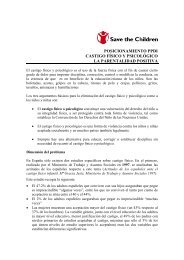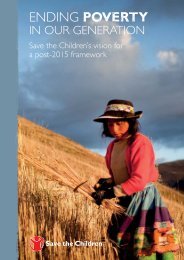Nutrition in the First 1,000 Days - Save the Children
Nutrition in the First 1,000 Days - Save the Children
Nutrition in the First 1,000 Days - Save the Children
Create successful ePaper yourself
Turn your PDF publications into a flip-book with our unique Google optimized e-Paper software.
48 appeNDix: <strong>the</strong> Mo<strong>the</strong>rS’ iNDex aND coUNtry raNKiNgS<br />
what <strong>the</strong> numbers don’t<br />
tell you<br />
The national-level data presented <strong>in</strong> <strong>the</strong><br />
Mo<strong>the</strong>rs’ Index provide an overview of many<br />
countries. However, it is important to<br />
remember that <strong>the</strong> condition of geographic<br />
or ethnic sub-groups <strong>in</strong> a country may vary<br />
greatly from <strong>the</strong> national average. Remote<br />
rural areas tend to have fewer services and<br />
more dire statistics. War, violence and law-<br />
lessness also do great harm to <strong>the</strong> well-be<strong>in</strong>g<br />
of mo<strong>the</strong>rs and children, and often affect<br />
certa<strong>in</strong> segments of <strong>the</strong> population dispro-<br />
portionately. These details are hidden when<br />
only broad national-level data are available.<br />
• Over half of all births are not attended by skilled health personnel.<br />
• On average, 1 <strong>in</strong> 30 women will die from pregnancy-related causes.<br />
• 1 child <strong>in</strong> 7 dies before his or her fifth birthday.<br />
• Nearly a third of all children suffer from malnutrition.<br />
• 1 child <strong>in</strong> 6 is not enrolled <strong>in</strong> primary school.<br />
• Fewer than 4 girls are enrolled <strong>in</strong> primary school for every 5 boys.<br />
• On average, females receive about 6 years of formal education.<br />
• Women earn less than 40 percent of what men do.<br />
• 8 out of 10 women are likely to suffer <strong>the</strong> loss of a child <strong>in</strong> <strong>the</strong>ir lifetime.<br />
The contrast between <strong>the</strong> top-ranked country, Norway, and <strong>the</strong> lowestranked<br />
country, Niger, is strik<strong>in</strong>g. Skilled health personnel are present at<br />
virtually every birth <strong>in</strong> Norway, while only 1 <strong>in</strong> 3 births are attended <strong>in</strong> Niger.<br />
In Norway, nearly 40 percent of parliamentary seats are held by women; <strong>in</strong><br />
Niger only 13 percent are. A typical Norwegian girl can expect to receive 18 years<br />
of formal education and will live to be over 83 years old. Eighty-two percent of<br />
women are us<strong>in</strong>g some modern method of contraception, and only 1 mo<strong>the</strong>r <strong>in</strong><br />
175 is likely to lose a child before his or her fifth birthday. At <strong>the</strong> opposite end<br />
of <strong>the</strong> spectrum, <strong>in</strong> Niger, a typical girl receives only 4 years of education and<br />
lives to only 56. Only 5 percent of women are us<strong>in</strong>g modern contraception, and<br />
1 child <strong>in</strong> 7 dies before his or her fifth birthday. This means that every mo<strong>the</strong>r<br />
<strong>in</strong> Niger is likely to suffer <strong>the</strong> loss of a child.<br />
chad

















